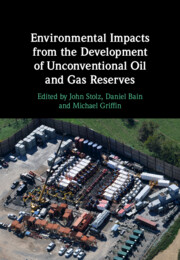Book contents
- Environmental Impacts from the Development of Unconventional Oil and Gas Reserves
- Environmental Impacts from the Development of Unconventional Oil and Gas Reserves
- Copyright page
- Contents
- Figures
- Tables
- Contributors
- Preface
- Part I Overview
- Part II Environmental Analysis
- Part III Case Studies
- 13 Evaluation of Potential Water Quality Impacts in Unconventional Oil and Gas Extraction
- 14 A Baseline Ecological Study of Tributaries in the Tenmile Creek Watershed, Southwest Pennsylvania
- 15 The Effects of Shale Gas Development on Forest Landscapes and Ecosystems in the Appalachian Basin
- 16 Managing TDS and Sulfate in the Monongahela River
- Index
- References
13 - Evaluation of Potential Water Quality Impacts in Unconventional Oil and Gas Extraction
The Application of Elemental Ratio Approaches to Pennsylvania Pre-Drill Data
from Part III - Case Studies
Published online by Cambridge University Press: 28 July 2022
- Environmental Impacts from the Development of Unconventional Oil and Gas Reserves
- Environmental Impacts from the Development of Unconventional Oil and Gas Reserves
- Copyright page
- Contents
- Figures
- Tables
- Contributors
- Preface
- Part I Overview
- Part II Environmental Analysis
- Part III Case Studies
- 13 Evaluation of Potential Water Quality Impacts in Unconventional Oil and Gas Extraction
- 14 A Baseline Ecological Study of Tributaries in the Tenmile Creek Watershed, Southwest Pennsylvania
- 15 The Effects of Shale Gas Development on Forest Landscapes and Ecosystems in the Appalachian Basin
- 16 Managing TDS and Sulfate in the Monongahela River
- Index
- References
Summary
Historical data can be used to evaluate water impacts from unconventional oil and gas extraction. “Grey” literature measurements of water quality before, during, and after unconventional extraction activities offer a potentially powerful resource for the evaluation of water quality impacts, and these data have rapidly expanded with regulatory response to the unconventional boom. However, historical data are limited in the variety of measured constituents and require substantial effort to reconstruct, revisit, and re-evaluate. Ultimately, available data were limited as data from only a single county (Bradford) included constituents necessary to use the vast majority of these elemental ratio systems. Further, even when data were available, they were often measured with relatively poor sensitivity, precluding their use as early indicators of contamination. This case study accentuates the continued need to establish background conditions, particularly in regions that have accumulated historical impacts, and further, ensure these characterizations incorporate sensitive testing for known chemistries associated with emerging and novel processes.
- Type
- Chapter
- Information
- Publisher: Cambridge University PressPrint publication year: 2022

